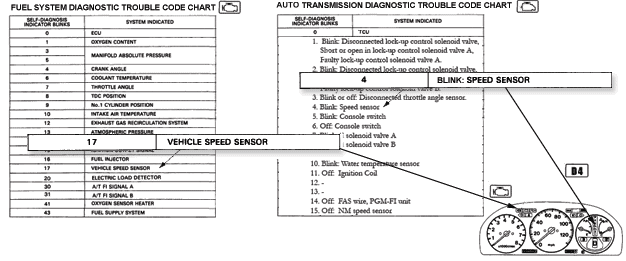|
|
||||||||||||||||||||||||||||||||||||||||||||||||||||||||||
Statistics
|

|
|||||||||||||||||||||||||||
Overview
The purpose and function of a VSS (Vehicle Speed Sensor) - The Honda Speed Sensor's main purpose is to transmit speed
data to the TCU, ECU, speedometer gauge and the
cruise control unit. It is
reading the frequency of a bobbin that is attached to upper casing that speeds past the
pickup sensor. The bobbin is a cylindrical or spool-shaped coil
or insulated wire, usually containing a core of
soft iron
which becomes magnetic when the wire is traversed by an
electrical current.
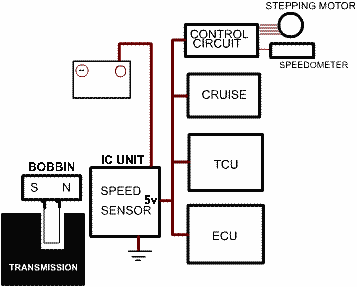 Fig 1: Vehicle speed sensor block diagram. 90, 91, 92, 93 Honda Accord or 92-95 Civic |
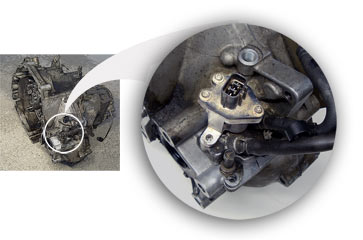
Fig 2: Speed sensor location, below the throttle body, access from the top of the car. See location description below. |
The faster the wheel spins, the faster the frequency the wheel magnet moves past the sensor thus the higher speed reading on your speedometer. The vehicle speed sensor counts the revolutions of the transmission output shaft. For a given vehicle, the Transmission Control Module considers a certain number of revolutions to equal a mile. A defective speed sensor can either set off the "S" light or fail to engage the cruise control, which also can affect other system controls. The result is that the TCU thinks the vehicle is running at zero speed from what it’s actually doing. The first thing you notice is an intermittent speedo reading then followed by a transmission error code after decellerating from a moderately high speed. The error codes will reset after every ignition off/on cycle.
Problem: The usual problem with the Honda/Acura vehicle speed sensor is the conducting surface wearing too soon. Once the surface begins to wear itself into the pit (of dirty grease) (see illustrated below) the speed sensor will stop working and throw out two codes below, usually at around 130 - 150K miles.
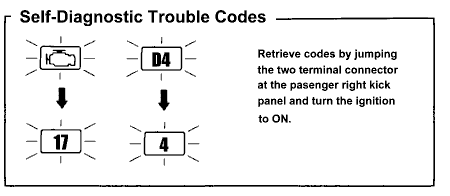
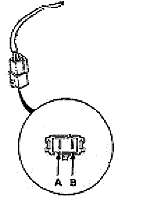
Code 17 of the ECU shown as a solid CEL light and Code 4 of the TCU shown as a blinking
"S" light or a blinking "D4" light is an indicator of a failed VSS circuit. 90%
chance the fault is in the speed sensor's contacts. To learn more about the
diagnostic codes see dtc.html. To go ahead and attempt
to solve this
problem see Solutions below.
Typical FAQ:
Will the transmission shift normally to all gears (1-4, plus lockup) when the speed sensor is broken or removed?
Yes. The transmission will shift up as usual. The VSS is mainly required for a proper downshift such as for descending from a hill. It will also shut off the engine if the speed is excessive. A failed VSS often won't create a limp mode. But most TCU's may go into a "limp mode" when there is a detected fault. The limp mode is usually mistaken for a transmission problem when the transmission refuses to shift. Please check for a stored code.
Solutions
Solution: The solution is to confirm that your VSS is dead by measuring for a voltage pulse. Follow the troubleshoot flowchart then perform the diagnostics. Then the speed sensor can be replaced. Also, the worn surfaces on the speed sensor's contact can be smoothen or resurfaced by the DIY. If the VSS works by this method then a new VSS isn't required.
Removing the VSS Steps:
- Raise the hood and find the VSS. ( See below or
see
figure 2.) On the Accord and Civic,
it is located on top of the transmission housing (or transaxle)
perpendicular to the axel of the vehicle, right below the
fuel filter or the air intake tube. The electronic VSS on the Accord is mated on top of
the power steering speed sensor gear shaft or simply a gear shaft. The power steering speed sensor
(on some models) has a few
steering fluid hose attached. Between the power steering speed sensor and
the vehicle speed sensor is a drive link. If the drive link is broken or missing there
will be no speed readings and the fault code 17 and 4 will show up.
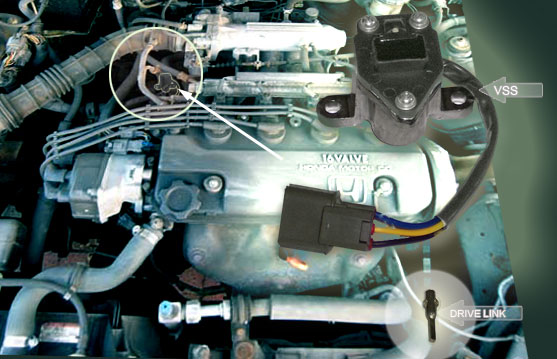
Figure 5: VSS located in the circled area way at the bottom of the engine compartment.
- Remove the intake tube if it's in the way. You can remove the speed sensor without the removing the intake tube on the Civic.
- Disconnect the electrical connector by pushing in the lock tab and pulling it straight up. (You can do this after step 4.)
- Remove the VSS bolt with a 10-mm socket with an extra long extension. Do not remove the Phillips screws.
- Twist the VSS from side to side and lift the VSS straight up.
- Pull out the drive link from the VSS to avoid loosing it.
Next step is to fix the VSS:
- The inside of the VSS can be opened using a Phillips screw driver.
- The inside can be cleaned with a carb cleaner.
- The surfaces in question can be rounded it off with a 400 grit sand paper and then finish off with a 600 grit or higher sand paper or an emory cloth. Or you can polish it as smooth as glass. ( See below for details) The smoother the surfaces, the less the resistance which helps prevent dirt built up and reduce wear. Then clean the surface with solvent.
- Contact grease is then added. (Do not mix grease.)
- The VSS's parts are reassembled.
Next step is to install the VSS into the transaxle:
- The drive link is inserted into the VSS and aligned according to the receiving female receptor on the gear shaft on top of the transaxle.
- The VSS installs by a slight twisting then bolted down to 9 lb-ft. Then the electrical connector is plugged in.
- The vehicle then undergoes a driving test. If the there are no speed readings on the speedometer (speedo) then see the flowchart below.
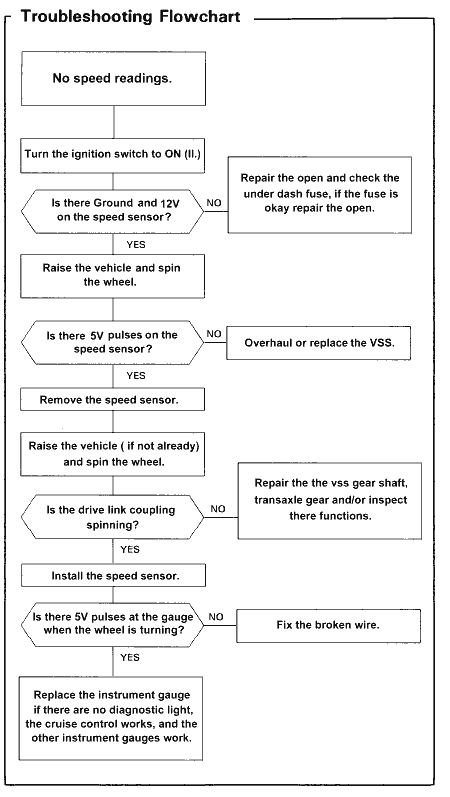
The first step is to check the connection for any deformation, corrosion or other visible signs of connection damage to the harness and/or the connector. Unplug the connector and look for corrosions or some type of crud. Scrape it then clean it then plug it back in after putting some electrical grease on the terminal to prevent any further problems. The next step is to jack up the car and take voltage readings (5V) pulses at the connector when the front wheel is turn by hand. You can do this after removing the the VSS and spin the drive link on the VSS by hand. This will eliminate any problems with the drive gears (where the VSS sits on.) If no pulses are found, confirm input voltages then inspect the inside of the VSS. Here's how to do this.
Follow these steps:
 ←
Terminals
←
Terminals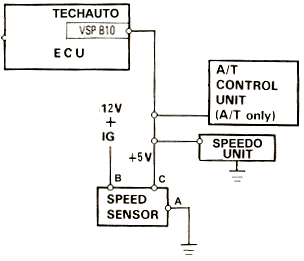 ←
Schematic diagram 2
←
Schematic diagram 2
1990-95 Accords
A = Blk (ground)
B = Yellow (12V battery)
C = Orange (output 5V pulses, to ECU, TCU and gauge)
IG = Ignition switch
How to check for power supply:
-
Using a DMM, probe the back of terminal B (+12V) (see image above, to the left.) The connector could be disconnected or connected.
-
Clip the other (-) end of the DMM to terminal A black wire (- ground) on the connector. There should be battery voltage.
How to check if the VSS is working (edit 8-25-09):
-
Using a DMM, probe the back of terminal C (see image above, to the left.) The VSS connector should still be connected to the VSS.
-
Clip the other (-) end of the DMM to black wire terminal A (- ground) on the connector.
-
Switch the ignition to ON.
-
Raise the passenger side of the car and spin the wheel slowly.
-
Read the blue decision box below.
There should be voltage readings from 0V to 5V on C (orange) terminal.
-
If there are no 0V to 5V pulse on the DMM but there is voltage between Yellow and Black wire then the speed sensor (VSS) is dead or the drivelink is missing or the gear shaft is broken.
-
If the voltages do go from 0V to 5V but the speedo doesn't work and there are no trouble codes then something is wrong with the lead to the speedo or the speedo is dead.
-
If you didn't find 12V between A (blk or body ground) and B (yellow) then check the ignition switch or the 7.5 - 10Amp fuse.
-
If you retrieved diagnostic trouble code: Check engine light 17 or Transmission error 4 then the speedo should be fine.
5. Turn the ignition OFF.
How to test the speed sensor: troubleshooting the VSS on a test bench.
Steps:
-
Connect 12V battery to B = Yellow. (It's safer to attach to the VSS to its harness on the car with the ignition ON.)

1990-95 Accords
A = Blk (ground)
B = Yellow (12V battery)
C = Orange (output 5V pulses, to ECU, TCU and gauge) -
Connect negative ground to A = Blk.
-
Connect the positive terminal of the multimeter to C = Orange and the black negative of the multimeter to A = Blk .
-
Spin the drive link by hand.
-
There should be voltage readings from 0V to 5V on C (orange) terminal as you spin the drive link.
Caution: Make sure the wire colors and terminals are as specified, which is specifically design for the Accord. Otherwise you may short circuit and damage the VSS. This is the reason why the test should be done on the vehicle.
How to check the speedo/ Speedo troubleshooting: Checking for vehicle speed signal at the gauge.
Steps:
-
Remove the instrument gauge and look for an orange wire located on one of the harness connector on the back of the instrument gauge.
-
Check the orange wire at the instrument gauge for 5V pulses.
-
Attach your probe on the orange wire (disconnecting the harness is okay) and the other probe to a body ground. If there are two or three orange wire on one or more connectors, pick the wire that has the "VSS pulses."
-
Drive the vehicle slowly.
If the voltage jumps from 5V to 0V repetitively when the car is moving then the speedo is most likely dead.
Author's note: The speedo is reliable device. A dead speedo or a dead rpm meter is most likely caused by the speedo bumping itself out of calibration or had jarred and cracked its circuit board solder joints (probably from an odometer tampering.) To attempt to calibrate the speedo to circuit board screw pressure, screw the three or four screws on the back of the circuit board to the correct screw torque then drive the car. Do this every mile until all the screws are at the correct point. For example. All three screws torque to 0.1 ft-lb in a crisscross manner at first attempt. Increase the torque on all screws at the next attempt in the same manner until the speedo works. This is an unconventional method but it works all the time for us but there is no guarantee for you.
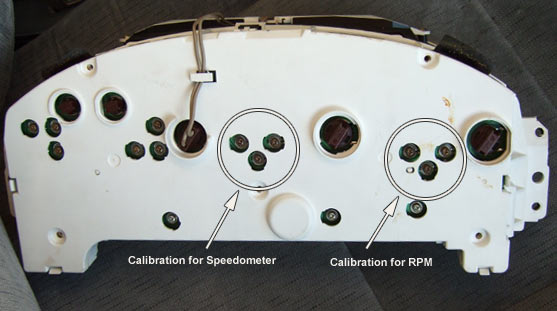
How to remove the dash panel and locate the calibration ports click here.
Signs of a faulty NM speed sensor: Located at the end of the transmission on some models, check for code 15 or transmission jerks hard when shifting. The NM speed sensor should be within 400-600 Ohms at 20-degrees C. See transmission.html#nc for details
VSS Removal:
Locate the VSS on top of the power steering speed sensor near the firewall on the passenger side, just below the throttle body or the fuel filter. Unplug the VSS connector by squeezing in the locking tab. Remove the bolt(s) that will fit a 10-mm socket wrench. Remove the VSS unit by lifting and twisting the unit upward. (Caution: Do not loose the drive link)
LOCATION
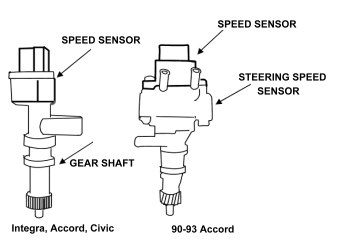 Figure
1
Figure
1
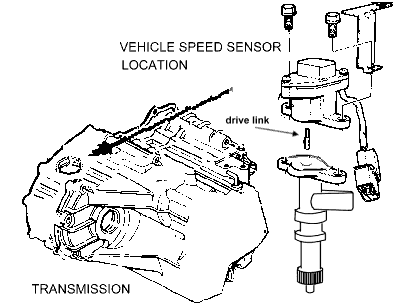
OVERHAUL/REBUILD
Remove the VSS's two phillips screws and gently lift the top off for inspection. Caution: DO NOT allow the spring pop out carelessly. If you loose track of it then you may have a hard time putting the parts back in correctly (since the drawings aren't as detailed. And their are no service manual drawings.)
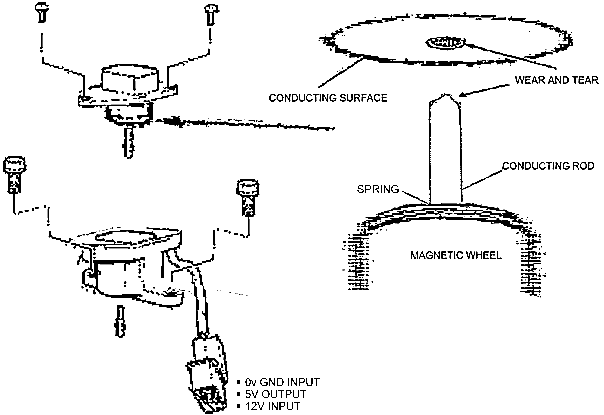 Figure
2
Figure
2
Inspect for signs of wear between the conducting rod and the conducting surface. The rod can be rounded off with a 400-600 grit sandpaper. The conducting surface on the opposite end can be treated the same way. Note: Add conducting grease to the treated areas when done.
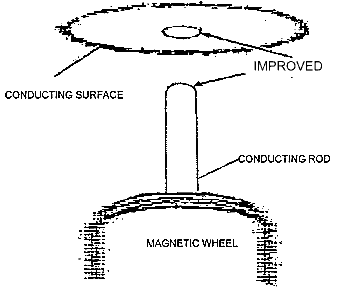 Figure
3
Figure
3
The new, improved polished surface should appear smooth, clean and shiny. If you want to get a near mirror polish use standard automotive finishing wet-dry papers....add a little diamond polishing paste up to 1 micron grade. Or use something like a ceramic sharpeners.
TOOLS REQUIRED
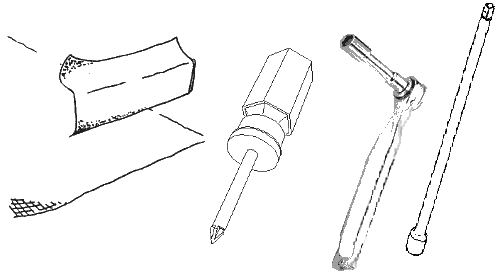
Figure
4 (The shorter socket extension isn't required.)
Technical details
KNOWN GOOD READING
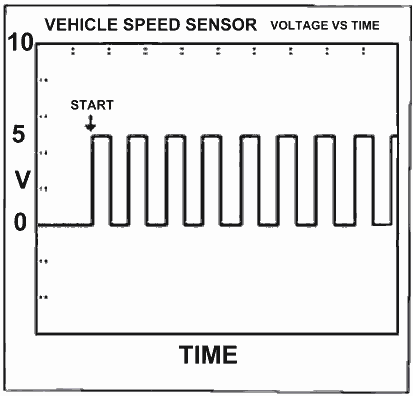
Other models:
Make: Acura
Model: 3.2TL
Year: 2003
Pulse Type: Digital
Color/Location: (YEL/RED, Blue/White, and GRN) Blue/White pulses - Pin 2

